
Food search in winter: Over 41 edible plants, nuts, roots and more for emergency food in cold weather
👉 The key facts from this guide
- Despite the harsh conditions, there are many opportunities to find food in nature during winter. You just need to know where and how to look.
- Wild herbs such as dandelions, chickweed, daisies, or sorrel can also be harvested in winter. They provide important vitamins and minerals.
- Nuts such as acorns, chestnuts, beech nuts, hazelnuts, and walnuts are nutrient-rich and can be collected in winter. However, they must be processed properly to be safe.
- Berries such as sloes, rowan berries, rose hips, wild cranberries, ghost apples, and wild grapes can also serve as a food source in winter.
- Seeds from plants such as maple, lamb's quarters, and sorrel can also serve as food. They can be processed into flour or eaten directly.
- Cones from coniferous trees such as pine and fir contain seeds that are rich in protein and healthy fats. They can be roasted and eaten.
Imagine you're in an emergency - lost in the snow, without food, your chances of survival dwindling.
If you don't know how to find food, the risk increases dramatically.
But don't panic, nature offers some edible food even when it's frosty - you just have to know where and how to look.
With solid knowledge of edible plants and animals you can defy hunger.
As a survival trainer with many years of experience in the wilderness and numerous survival courses, I will show you how to discover and safely use more than 41 food sources in winter.
Trust my expertise so that you don't go hungry even in the coldest winter.
The first glance is deceiving - you can still find food in winter
Our ancestors prepared for winter in the milder seasons by collecting and storing durable food.
Only in emergencies did they need to find additional food. Because finding food in winter is challenging and usually yields comparably little.
Many plants die off, and only a few seeds and fruits remain that we can use for sustenance.

Hunting was also much more laborious and required a lot of energy. All in all, it seems that winter doesn't offer much food for us.
But the first glance can be deceiving - you just have to know where to look.
Because even in winter, there is life everywhere, just a little dormant and better hidden.
This is also reflected in the survival food pyramid:

Therefore, I would like to give you the most important sources of food for winter. You need to search for food once you have taken care of shelter, fire, and water.
As often, the combination of different sources and knowledge resources prepares you for survival in winter.
You won't get far with just one of these tricks, but with a variety of potential sources of food, you have excellent chances of finding edible in winter.
1. Wild herbs as food in winter
Although there is much less green to find in winter than in other seasons, some plants still find their way through the snow and cold.
In mild winters or early winter, you can often still harvest dandelions, chickweed, daisies, or sorrel. Nettles are also findable in winter. Often, the seeds remain in winter or the roots can serve as emergency food.
Chickweed
Chickweed remains active even in colder months. Besides its benefits for the kitchen, the plant has a soothing or preventive effect on lung problems or colds. Perfect for the cold season.

This type is a low-growing herbaceous annual plant that often forms a carpet on the ground. The small, egg-shaped, simple leaves grow in opposite branching on the round, green stems.
Chickweed has white flowers that appear to have 10 petals, but on closer inspection, there are really only five petals, which are partially split.
The chickweed, which is native to Europe, is now found in the temperate regions of the northern hemisphere.
The common chickweed (Stellaria media) is usually delicate and mild in taste and not as fuzzy as other species.
The tender leaves and stems can be eaten raw or cooked. Chickweed can also be used as an anti-itch wrap for irritated skin or eaten to relieve constipation.
I recommend taking a closer look at the power plant chickweed. It is definitely not as inconspicuous as it is often portrayed. Therefore, read my detailed guide on chickweed.
Stinging Nettle
Stinging nettle is a plant that has been used for centuries as food, medicine, and textile. It is also a plant that serves as emergency food wonderfully.

Stinging nettles are rich in iron, calcium, potassium, manganese, and vitamins A and C. They are also a good source of fiber and protein.
This plant can be eaten raw or cooked. In an emergency situation, you can add them to dishes like soups or make tea out of them.
Stinging nettles can be harvested at any time of the year, but they are most abundant in the spring when they are tender enough to eat raw without cooking them first.
If you want to learn more about stinging nettles, read my guide "Stinging Nettle - This Versatile Power Plant Should Become Your Outdoor Friend".
Dandelion
Dandelion is edible and can be used in a variety of dishes. It is also good for your health as it contains vitamin A, C, K, iron, potassium, and calcium.
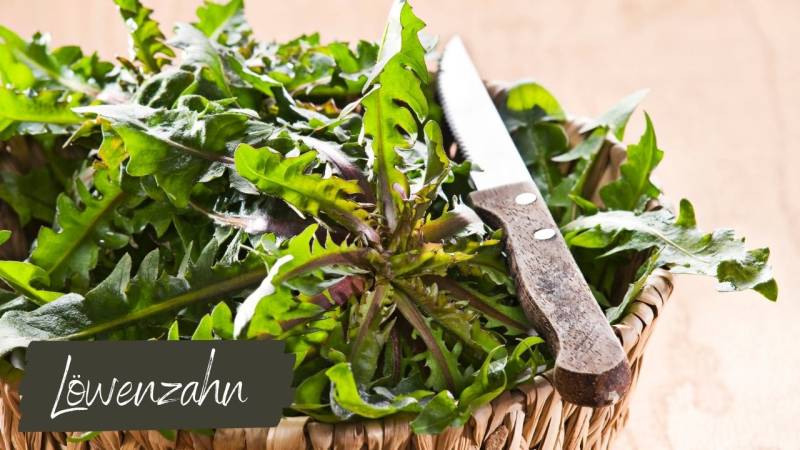
Check out my detailed guide to the powerhouse plant dandelion.
Daisy
The daisy is a flower that is often used as an emergency food source. This is because it has a high water content, which means it can be eaten raw.

It also contains some protein and vitamin C and can be found in many different climates.
Read my comprehensive guide: Healing plant daisy in the spotlight (edible and delicious)
Sorrel
Sorrel is a great emergency food that you should have in your forest pantry.

It is full of vitamins and minerals and has a tangy, lemony taste.
You can eat it raw immediately or use it as an ingredient in soups, stews, or salads.
Read more: Plant portrait of sorrel - the vitamin C bomb from nature
Wild onions and garlic
Spicy and delicious wild onions turn your wild-caught fish and game into a royal meal.
Versatile and frost-resistant, these plants offer great wild flavor throughout the winter season.

Your first step to ensure that a plant is really an onion or garlic is to look for the bulbous root and rounded stem that onions and garlic have in common.
Once this test is passed, move on to the smell test. Scratch the onion or crush the green tips, and you should immediately smell the familiar onion scent.
The plant contains numerous sulfur compounds that mix with the salt in your tears to form a weak sulfuric acid - the reason your eyes burn when you chop up these plants.
Various wild onion species can be found all over the world, including in Germany.
The tender tips and juicy onions can be eaten raw or cooked.
Warning: Onions and garlic are a group of plants that are edible and generally very tasty for humans. But don't just eat anything that is shaped like an onion.
The larger family to which they belong is the lily family, which can be a problem for collectors as some lilies are poisonous and look like onions at first glance.
Watercress
Watercress or Yellow Cress (Nasturtium officinale) was once considered a superfood and has since made a comeback as a culinary staple. This ancient leafy vegetable was once served as much more than just a side dish.

Watercress has nutritional and medicinal properties. Its relationship with mustard can become more apparent when eaten raw.
It has a peppery taste when raw, but once cooked, the peppery flavor diminishes and it tastes more like a green leaf. Add it to soups, stir-fries, and salads.
Also read: Watercress: spicy and healthy wild herb and medicinal plant with a vitamin D kick - It used to be grown because it is so healthy: Watercress. It is one of the best wild and medicinal herbs and provides you with many vitamins.
Common purslane
Common purslane (also called Portulaca oleracea or winter purslane) has small heart-shaped leaves that grow all winter in slightly milder regions.

If I had to compare it to something, I would say the taste is similar to spinach.
It is slightly sour but still mild, sweet, and nicely crunchy when eaten raw. When cooked, it loses its crispness and becomes slightly slimy.
2. Chestnuts, acorns, and walnuts as winter food
For animals, nuts are essential in winter. Many animals collect their winter reserves throughout the year, but other species also collect in winter or eat their finds directly from the ground.
Therefore, you can collect nuts and use them for yourself. Only in the snow, you don't have to look down, but up. If you find the respective tree, you can dig for the nuts underneath it.
Acorns
Acorns are one of the most common tree nuts and with a little processing, they provide us with a nutrient-rich power food.

There are approximately 600 species of "oak" worldwide. This list includes deciduous and evergreen tree species that occur in cool climates up to warmer tropical latitudes. Oaks have alternate simple leaves in a variety of sizes and shapes. The fruit of the oak is a nut called an acorn.
The bitter acid in acorns can be easily removed by breaking them into pieces and soaking the acorn meat pieces in warm water for an hour, changing the water repeatedly until the bitterness is gone.
Acorns should not be eaten raw as they contain toxic tannic acid. Soaking them can remove the tannic acid. You should change the water regularly.
You can then cook or roast them. Alternatively, you can dry your acorns and process them into flour.
Let's take a look at what you can make from the seeds (acorns):
- Patties or puree - immerse the acorns in hot water, then peel and puree them. Put them in a cotton cloth and wash them several times in water to remove the bitterness.
- Acorn coffee or flour additive - roast the finely chopped acorns
- Leaves, dried and powdered as a flour additive
Acorns taste herbaceous, nutty, and a little bland - but don't be fooled. These nuts are rich in fatty oils. Leaves and bark are bitter (8-20% tannins, The bark is used for tanning animal hides).
Warning: Eating acorns that still contain too much tannic acid can cause nausea and digestive problems. Also, make sure you don't pick horse chestnuts. Once they have fallen out of their shells, horse chestnuts can look similar to acorns, but unlike acorns, horse chestnuts are poisonous and cannot be leached.
Chestnut
You won't see chestnuts everywhere in Germany as they mainly grow in western Germany. If you travel through western Germany, you may be lucky enough to find them.

Chestnuts are an edible fruit that is often harvested in August-September. They taste nutty-sweet and their leathery skin is easily peeled.
The fruits of the sweet chestnut are starchy nuts and give you a lot of power.
Warning: With chestnuts, you must not resort to the well-known horse chestnut, but must look for the rare sweet chestnuts (sweet chestnut).
Beech Nuts
Every September, I remember that the beech trees are full of ripe, edible beech nuts.

They taste like almonds. But not raw in large quantities as they make you sick and give you headaches or stomach aches.
Peel the beech nuts and roast them over the fire. This breaks down the problematic substances. You can then eat them pure, as a coffee substitute (here's how to brew coffee), or use them as a flour additive.
Beech nuts are great: they contain up to 45% fatty oil, 40% starch (carbohydrates), up to 25% protein, and vitamins B6 and C.
Furthermore, you can even make cooking oil from beech nuts, which may be difficult in the wild.
As beech nuts are a true survival food, my guide to beech nuts has all the important information - how to collect, process, and eat them.
Hazelnut
Hazelnuts are often collected in September from common hazel shrubs. They can be eaten raw or roasted. But you can also find them in winter.

Hazelnuts are rich in fatty acids, sugar (up to 5%), protein (20%), vitamins B1, B2, E, calcium, magnesium, manganese, silicon, phosphorus, potassium, and trace elements.
Survival fact: Our ancestors already knew hazelnuts in the Stone Age. They are nutritious and can be stored well. A porridge made from the nuts is also said to be helpful for (suppurating) wounds.
Walnut
These remarkable trees provide food, medicine, dyes, and useful wood. When the nuts are present, they are quickly identifiable.

Walnuts are tall, deciduous hardwood trees with round or elongated nuts. Black walnuts (Juglans nigra) look like green tennis balls when freshly fallen, although the rough, round shells turn black in winter.
A walnut tree can grow up to 25 meters high and is supposed to be productive for 10 or more years before it stops bearing fruit. However, it also takes several years for the tree to bear fruit in the first place.
You will find a lot of magnesium, potassium, calcium, copper, vitamins (especially vitamin E), and fatty acids in the nuts. According to recent studies, walnuts have a cancer-reducing effect.
Warning: Wear waterproof gloves (if available) when working with sticky, wet walnut shells. The walnut shell flesh not only stains your skin in a strange color, but some people develop painful skin irritations from contact.
3. Berries as Winter Food
Aside from freezing cold, frost and snow also advance the ripening of many fruits. At the same time, the frost preserves the berries and you are therefore moving through a huge refrigerator.
Blackthorn
In winter, when there are no other sources of food, people eat blackthorn to survive. After the first frost, you can eat the blackthorn berries.

Blackthorn has a high sugar content and is usually processed into syrup or jam. It is also a good source of vitamin C and vitamin A. They say that if you eat blackthorn every day for three months, you will never get sick.
Rowan Berries
Rowan berries are found throughout Europe and Asia and are used as a food by many cultures. The wild berries can be harvested no later than October after the first frost.

Although they are not poisonous, rowan berries taste very bitter when eaten raw. Therefore, you should cook them to get rid of the inedible parasorbic acid in their raw state.
Rose Hips
Furthermore, I would like to mention the vitamin C-rich rose hips, which enrich the bird world on our wild roses from autumn onwards. We too can make use of them over the winter and meet our vitamin C needs with them.

This perennial rose variety is a woody plant with finely serrated, compound leaves that can last into winter. The stems have alternate branching and sharp, curved thorns. The branches have brightly red rose hips that carry an average of 8 to 12 light yellow seeds per fruit.
Both invasive and native wild roses occur throughout the northern hemisphere. Wild roses prefer open soils and pastures.
The flesh and skin of rose hips can be eaten raw or the entire rose hip can be steeped for rosehip tea. The spicy, sweet, red-colored fruit is a good source of vitamin E and also a vitamin C powerhouse, containing seven times the daily dose.
In Finland, rose hips were used as emergency food for animals in winter when no other food was available. The Finns called them "winter oranges."
Learn more about this great plant in my guide "Harvesting and Processing Rose Hips: The Underrated Vitamin C Bombs (+Recipes)."
Cranberries
Cranberries are basically nature's freeze-dried raisins.

With all the beautiful birds in my area, there's usually no grape left and unfortunately they don't really occur wild very often.
Ghost Apples
Ghost apples are the apples that remain on the trees after the last harvest.

Some just like to be the last ones. Often what you find in the skin of an apple is only good for compost, but hardy trees stay strong and your ghost apples are full of surprises.
Wild Grapes
Wild grapes are essentially nature's freeze-dried raisins.

With all the beautiful birds in my area, there's usually no grape left and unfortunately they don't really occur wild very often.
4. Seeds as food in winter
Seeds may be small, but they can serve as emergency food during the cold seasons.
Maple seeds
Maple seeds are those fun little helicopter-like seed pods that spin as they float through the air. Surprisingly, I know many people who didn't know they were maple seeds.

Anyway, peel off the outer shell and there are two small edible seeds. They're not nearly as delicious as maple syrup, but you can still eat them.
I think they're tastier in the spring when they're fresh and crispy, but you can enjoy them all year round.
Lamb's quarters
Lamb's quarters are also known as wild spinach. All seeds from the white lamb's quarters are fully edible - some are just easier to find and process than others.
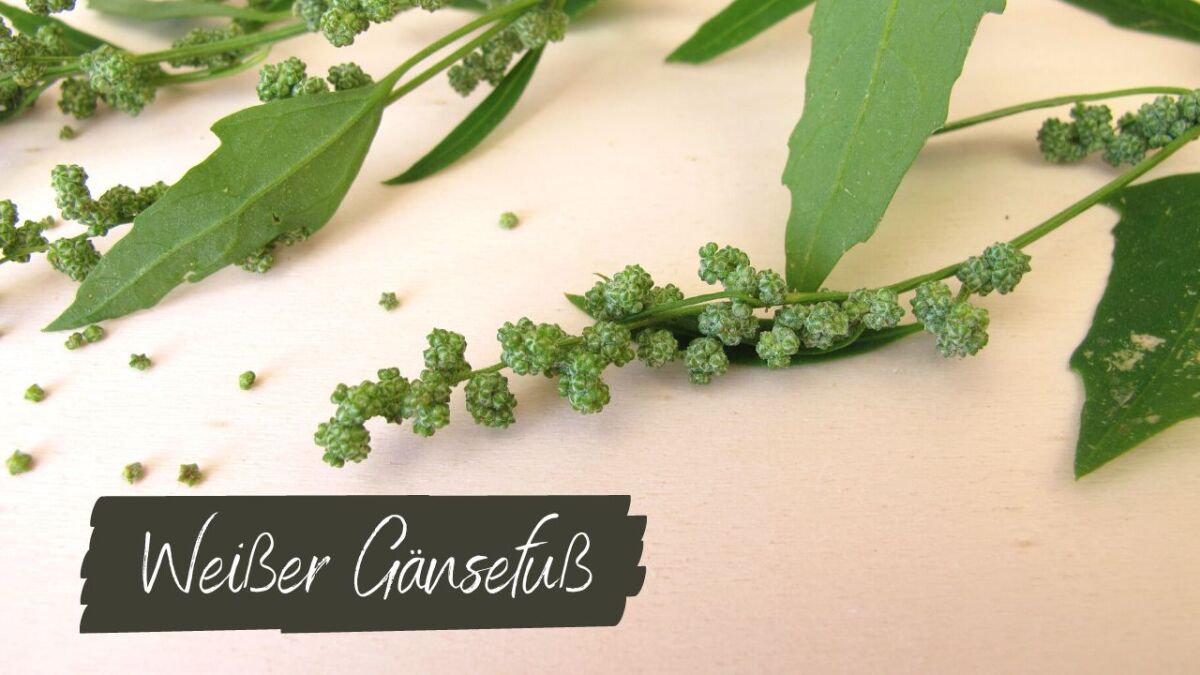
The tiny black seeds are produced in the fall and hang from stiff stems until they drop or are harvested.
Find out how to harvest the seeds and why the white lamb's quarters is not commonly seen in my guide to the white lamb's quarters.
Sorrel
Sorrel seeds are related to buckwheat and are used in a similar way. These seeds make tasty flour.

All you need is a few minutes to make a liter of sorrel seeds. The sturdy stems also hold up well under heavy snow, making them easy to find.
5. Cones as food in winter
Pine nuts are rich in protein and healthy fats. But it's not just the pine or fir that offers seeds in its cones, but also the spruce tree.

The cones of coniferous trees are usually quite high up, but some cones may fall to the ground. You can also look for fallen trees (More about the danger of fallen trees) to access the cones.
To harvest the seeds, break open the cone and look into the seed compartment. With a little luck, you'll find a seed in a scale inside that you can then roast and eat.
Although the yield is initially small, the energy density is very high, making the kernels ideal for emergency food. When consuming raw, it's important to chew the kernels well to access the nutritious ingredients.
6. Roots and vegetables as food in winter
Many plants withdraw their energy into their roots for winter survival and remain underground during the season.
They become milder and easier to enjoy than in the summer. Additionally, the energy is much more centered and the roots contain some vital nutrients.
To avoid wasting energy digging and damaging the plant, you should be certain about the identification of the appropriate plants. Here are some easily recognizable plants:
Great burdock
I'll be honest, I don't like burdock roots. Nevertheless, many people love them, including a close friend. The edible taproot has an earthy taste and a bit of bitterness.
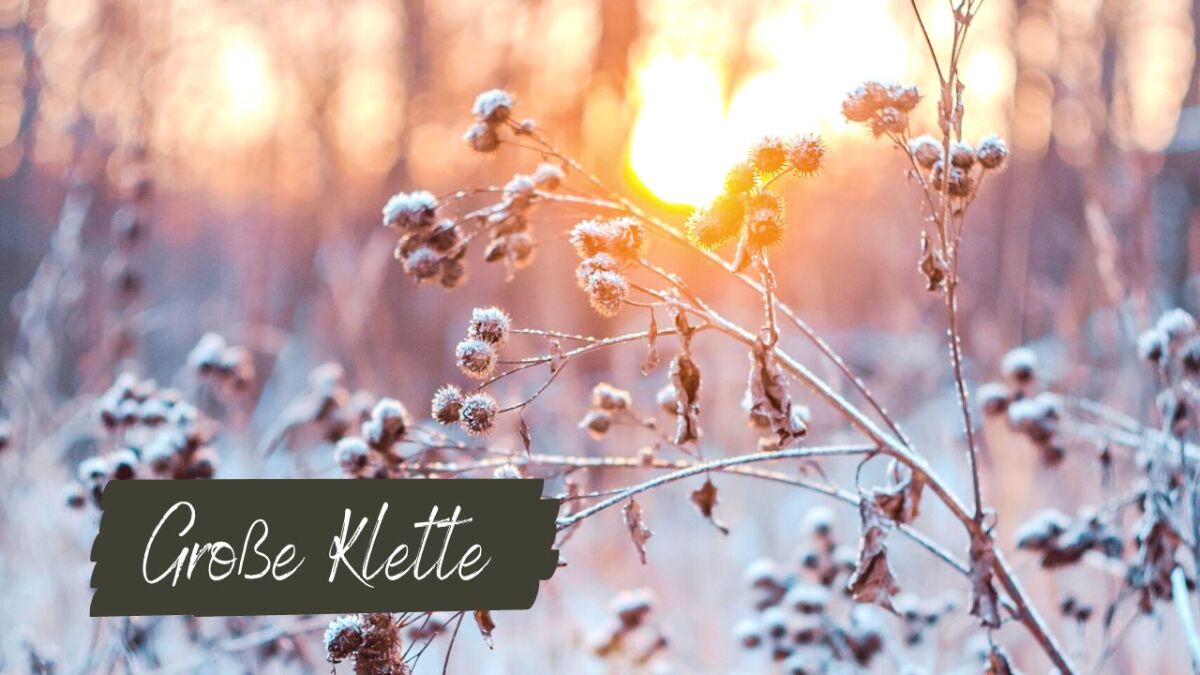
I think they're best used in a burdock tincture to combat inflammation or processed into herbal cocktails, but you can also cook and eat them.
Burdock stems are edible and tasty in the fall when they're green, and in my opinion, they're by far the best-tasting part of the burdock. Unfortunately, they don't keep until winter.
They dry out in winter and generally remain upright because the burdock-covered seed balls want to stick to passing deer (or humans).
The plant remains with the seed balls on top of the surface, making it easily visible.
Other edible roots in winter:
- Wild parsnip
- Wild carrot
- Jerusalem artichoke
- Chicory
- Thistle
Cattails and reeds
The same goes for cattails and reeds. They are easy to find, but their proximity to water is a problem when it is frozen.
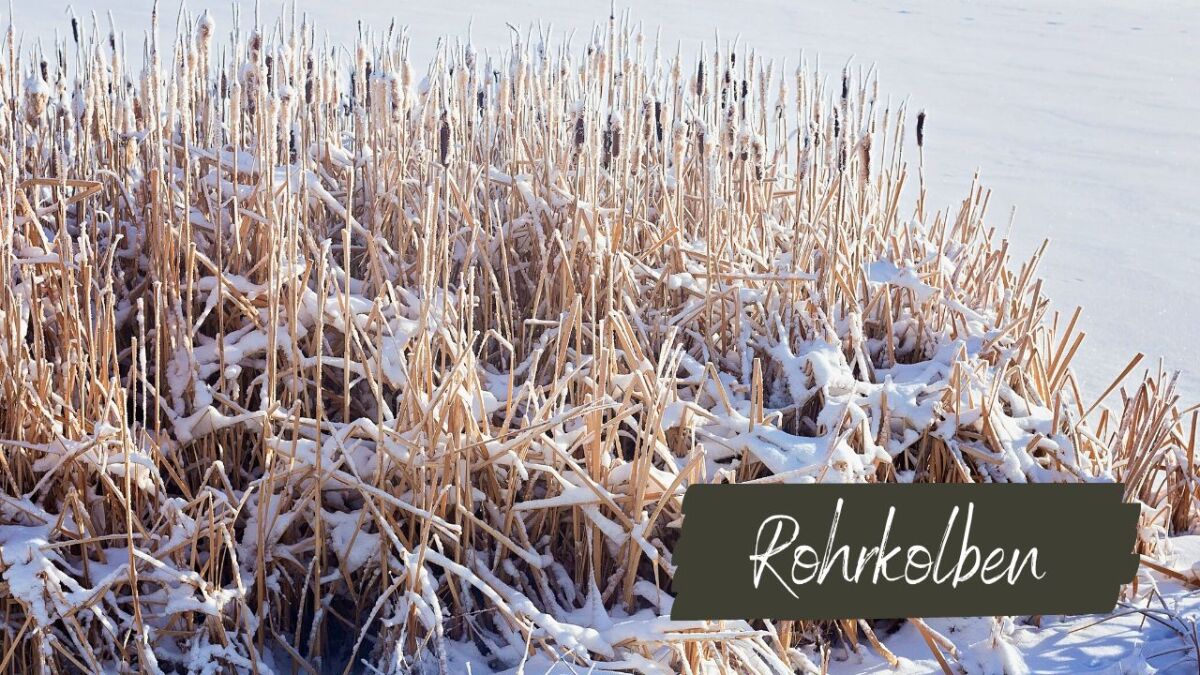
This makes digging them up very difficult if not impossible. To save energy, you should only rely on them on frost-free days.
The root is very rich in starch and perfect for food (tastes like chestnuts). Since the roots are very fibrous, they should be cut into small pieces across the fibers and cooked after washing.
You can also make a puree out of the cooked roots. However, you would need a sieve for that.
Or you can place the cattail root directly into the fire. After roasting, remove the black skin and enjoy the mild flavor.
Evening primrose
Finally, I would like to mention the evening primrose. This root was already considered very powerful by the Native Americans and enriches your winter diet with protein and many minerals.
The seeds are also a very valuable raw material. The small, black seeds (available from September) in the capsules are also edible and very nutritious because they are rich in oil.
The well-known evening primrose oil, rich in gamma-linolenic acid (GLA), an important omega-6 fatty acid, is pressed from the seeds.
This oil is highly valued in cosmetics and natural medicine because it contains essential polyunsaturated fatty acids that are rarely found in plants (and are important for us humans).

For more details on collecting and finding evening primrose, take a look at my guide to evening primrose: Evening Primrose: Your Shining Star for Survival Cooking & Wilderness Pharmacy.
7. Mushrooms as food in winter
Mushroom hunting is most popular in autumn. However, the third kingdom of living beings can also be found in winter.
However, as often, you should not eat anything unless you are 100% sure about it.
Depending on where you are, you can find a whole range of different mushrooms in the forest in winter. You should definitely inform yourself about mushrooms in winter.
Judas Ear
An initially unappetizing representative is the Judas ear.
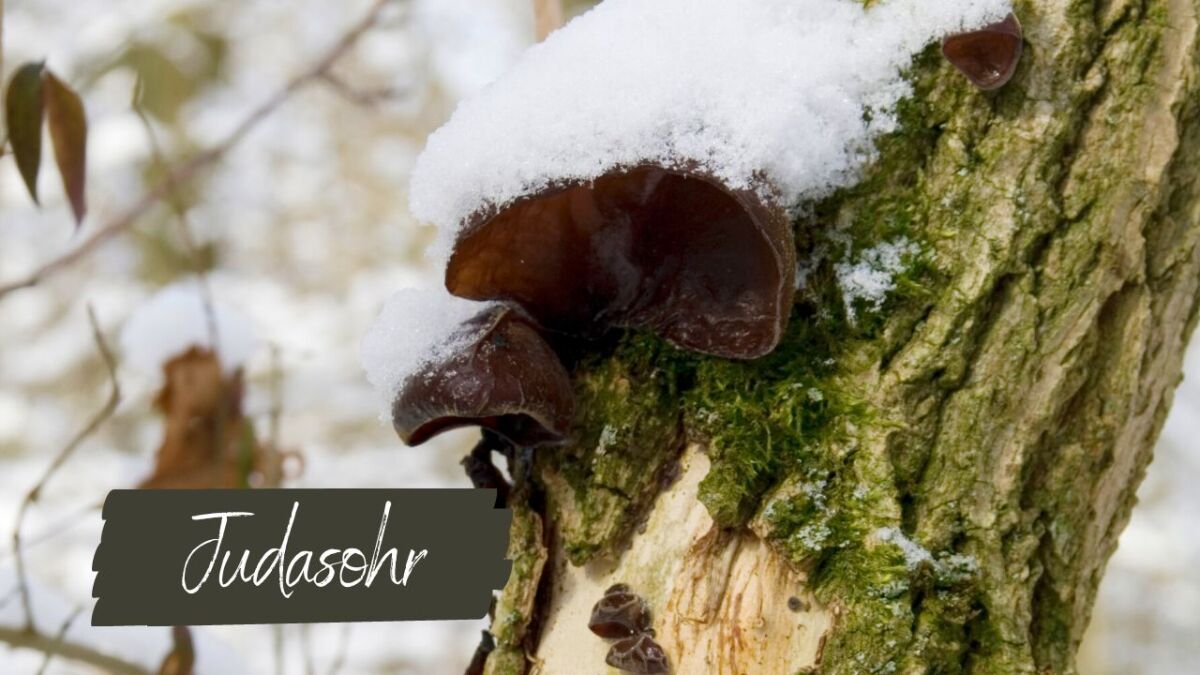
Do not be fooled by its appearance, as the mushroom is considered absolutely healthy in Chinese medicine and tastes very mild when fried.
Oyster mushroom
The oyster mushroom is well-known worldwide and can often be found in supermarkets, but you can also discover it in the forest at low temperatures. It generally grows on deciduous trees and tastes wonderful when fried.

Velvet foot mushroom
The common velvet foot mushroom is particularly easy to recognize with its honey-yellow color.

The mushroom grows on tree stumps and is also highly valued in Chinese medicine. It is said to warm us humans from the inside due to its cold resistance. Read more about this great winter mushroom.
8. Insect larvae as food in winter
Some insects also stay with us in winter and often seek refuge in cavities or in the ground for protection.
Beetle larvae in particular can be found well in dead wood and are in a state of winter dormancy in winter.
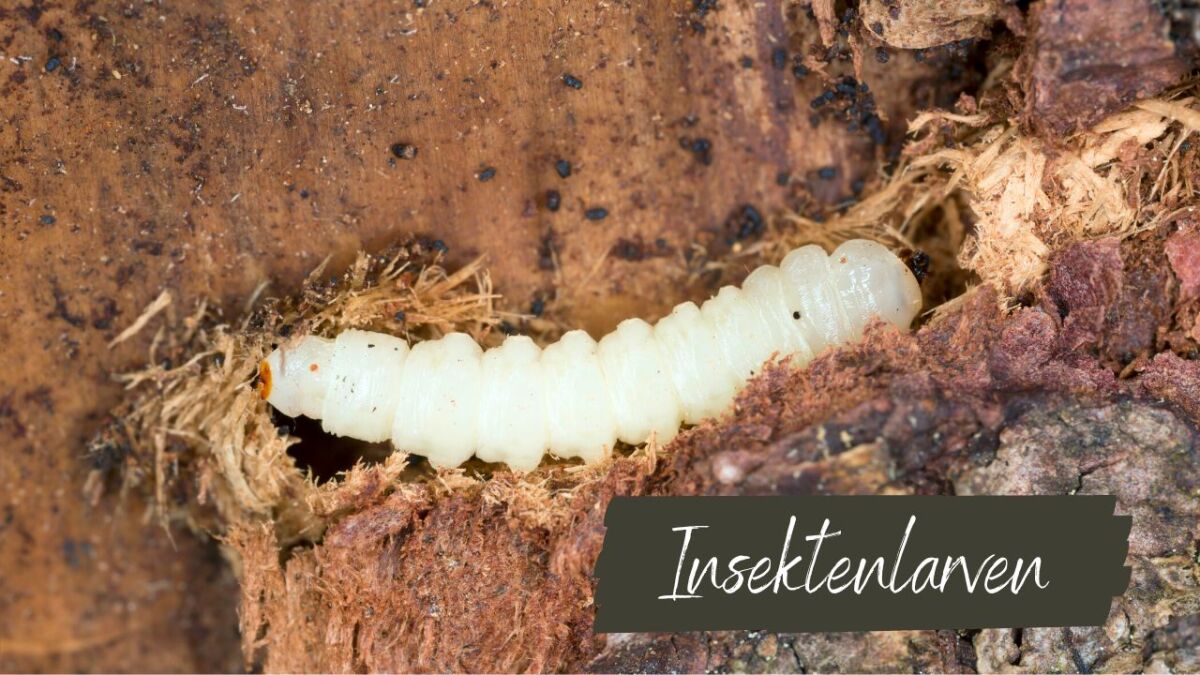
To get to the protein snack, you need to drill a little in the dead wood and ideally work it with a tool (like your essential wilderness equipment).
If you cannot find any larvae, you can also rely on various other insects. Ants, termites, and even crickets can be tracked down in winter with a little luck.
Even if the animals are often consumed raw, I clearly recommend cooking them (for which you need a fire). Only heat kills bacteria and parasites.
Reading tip: Can you eat ants to survive?
9. Tree sap, bark, and leaves to get food in winter
Maple sap
Friendly, familiar, and delicious maple syrup adorns many breakfast tables around the world and is a welcome treat for survivors in an otherwise dark season.

Maple trees have different bark colors and patterns as well as different growth forms, but they are all oppositely branched deciduous trees. To achieve the best results, look down and check which leaves are there. There are pointed, mountain, and field maples and you can find the differences in my guide.
Unfortunately, the sugar maple (Acer saccharum) only grows in southeastern Canada and northeastern USA. Maple syrup has one of the highest sugar concentrations of the maples. But our native maples also give off this delicious sap.
However, not only maple trees give off sap. You can also use the following trees:
- Birch
- Ash
- Lime
- Poplar
February is the best month for sap production for most tree species.
Also read
The liquid gold of trees: 16 trees you can tap for syrup – Syrup from nature – doesn't that sound tempting? In this guide, you will learn how to obtain valuable and delicious syrup from 16 different trees.
Bark as a Last Resort Food
The inner bark of many trees is easy to harvest and contains starchy calories that are easily accessible in winter with a sharp knife or even a pointed stone or stick.

Trees like pine, aspen, beech, maple, and linden are an excellent choice. Native North Americans made a bacon from pine bark by marinating the inner bark in salt and spices before roasting it in strips until crispy.
In Rogers Herbal Manual, herbalist Robert Rogers gives a recipe for tamarack bread:
"Scrape the softwood and inner bark from the tamarack (American larch), mix it with water and ferment it in the dough to mix with rye flour. Buried under the snow for one day. When fermentation begins, the dough can be cooked as a storage bread or dumpling. The sweet wood pulp serves as sugar for the yeast in the rye."
Find all information about eating tree bark and how to harvest it in my guide "Can You Eat Tree Bark to Survive?".
10. Hunt for Food in Winter
With the right equipment and training, hunting can also provide you with protein. In addition to conventional hunting with a bow, crossbow, or rifle, you can also use traps.

Here is a guide to one of many possible traps: the deadfall trap.
It is essential to cook the meat thoroughly to kill all parasites and bacteria.
11. Moss, Lichens, Buds, and Algae as Food in Winter
Unfortunately, we are not close to the sea in Germany, so searching for food near the sea is almost out of the question. But I still want to include it here, maybe you are in a different country in a survival situation.

I have heard of gatherers searching for all of these things in the winter months:
- Lichens (read more here)
- Moss (not recommended, low nutritional value)
- Seaweed
Eating Buds in Winter
Many people wonder if it's possible to eat buds. The answer is yes, there are many edible buds. However, you shouldn't just pick and eat plants of any kind, as some plants can seriously harm your body if consumed.
But there's nothing wrong with trying the small bundles of minerals and vitamins you find in our forests. Why not try the buds of beech or birch?

What to Consider When Searching for Food in Winter?
1. Increased Caloric Needs
In cold temperatures, our bodies burn a lot of calories to keep us warm. This is something you should keep in mind.
This also means that you need more food to meet your calorie needs. This makes searching for food in winter much more challenging. In addition to the low availability, your body also needs more calories.
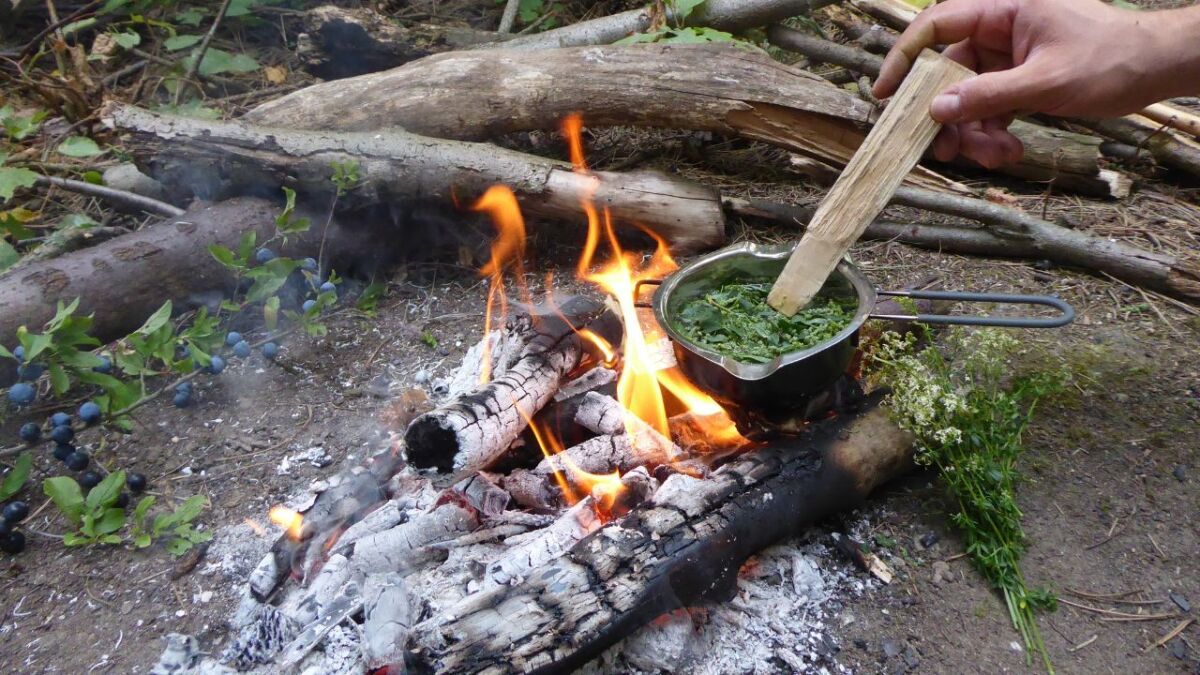
2. Shorter Days
In the summer, we're blessed with long days and can take our time with all necessary preparations in a survival situation.
In winter, everything becomes a bit more difficult because the days are much shorter. Therefore, it's essential to plan your day according to your resources and energy.
Being out at night in unknown areas with low temperatures and no food can have fatal consequences.
3. Moisture
If you already have a stock of supplies, they must be stored safely. In addition to rodents that can plunder your supplies, moisture and mold can also be a problem. Warmth is ideal for reducing moisture.
4. Rodents
Animals that are not or not yet in hibernation will continue to search for food. If they find a whole heap of food, it can be destroyed in the short term.
In addition to the fact that your well-stocked food is then gone, rodents also carry parasites and diseases.
Keep your food supplies safe and prepare for all eventualities.

How to Find Food When Nothing is Visible
Imagine you now have the knowledge from this guide, but you're in the forest and see no visible food.
You could wander around and hope to find something. However, this could take a long time and require a lot of energy.
A promising way to get food is to follow animal tracks. In my guide "Learning to Read Tracks for Beginners (with many picture examples)," you'll find many signs of animals, and in my Track Seal Database, you'll find an overview of the animals.

Native animals know their spots with food and also water.
You'll be able to find things like dried fruits, nuts, and delicious mushrooms.
Conclusion on Searching for Food in Winter
If you're in a survival situation in winter (What is Survival?), you definitely don't have to starve to death anymore.
There's more emergency food in nature than you might think; you just have to know where to look.
As mentioned above, you should combine your knowledge to dramatically increase your chances of survival. And you should master the most important survival skills.
But even without an acute survival situation, the compressed knowledge here can be wonderfully applied and invites you to visit the forest even on gray winter days.
Just keep one thing in mind: You're not alone out there.
Birds, rodents, and other forest dwellers also depend on the sparse food supply. Therefore, don't collect the entire stock, but always leave two-thirds of the occurrence to the creatures.
Finally, I recommend my guide for deeper knowledge: 7 Survival Options for Finding Food in the Wild.

Sources for the guide
https://survivallife.com/winter-foraging/#Acorns_Horse_Chestnuts_and_Black_Walnuts
https://www.br.de/wissen/gesundheit/ernaehrung/pilze-winter-winterpilze-geniessbar-fungi-100.html
https://survivalmentor.at/wp-content/uploads/2017/01/10-Nahrungsquellen-im-Winter.pdf
https://www.geo.de/reisen/reise-inspiration/was-man-im-winter-im-wald-essen-kann-30933460.html
https://www.hausgarten.net/pflanzen/baumlexikon/pinienzapfen-oeffnen-knacken.html
https://www.kostbarenatur.net/wurzeln-im-winter-sammeln-essbare-wildpflanzen/
https://www.nabu.de/umwelt-und-ressourcen/oekologisch-leben/balkon-und-garten/tiere/insekten/25090.html
https://www.plantura.garden/obst/hagebutten/hagebutten-pflanzenportrait
https://www.emsa.com/blog/beeren-und-wildobst-im-winter
https://www.1001frucht.de/magazin/aktuelles/warum-sind-nuesse-im-winter-so-wichtig
https://www.mdrjump.de/thema/quicktipp/herbst-eicheln-kastanien-sammeln-regeln-100.html
https://de.wikipedia.org/wiki/Tannine

Author of the guide
Martin Gebhardt
Hey, I'm Martin. On my blog, you will learn the basics and numerous details about living in the wild. I think survival, bushcraft and the good life in nature are the keys to happiness. Find me here on Instagram or on YouTube. You can find more about my mission on the About Me page.
Was this guide helpful?
60 people found this guide helpful.
5.00 out of 5 points (60 Ratings)
Comments (0)
This post may contain affiliate links. So if you click on the links and make a purchase, I will receive a small commission at no additional cost to you. Click here, to learn more about it.


